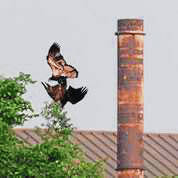Nesting success at U.S. Steel Irvin plant: 2 juvenile bald eagles take playful flights
Two juvenile bald eagles raised at a nest on the property of the U.S. Steel Irvin plant in West Mifflin have been putting on impressive aerial displays around the plant.
“Our employees have enjoyed watching from a distance as these eagles, ‘Irvin and Claire,’ as our team named them, continue to thrive on our Irvin Plant property for a second year,” said Amanda Malkowski, spokeswoman for U.S. Steel Corp.
“We are honored that they continue to call U.S. Steel home.”
What seems to be an unlikely nesting spot — the grounds of a working steel mill — is alluring to the formerly endangered raptors.
Although there are two sets of railroad tracks, there is little disturbance to the birds, said Douglas Bergman, a game warden with the Pennsylvania Game Commission. Their nest is in a wooded section of the plant’s grounds along the Monongahela River.
“Those birds are protected from human foot traffic, and the river has provided them a good food source,” he said.
“The mill is willing to give the eagles the protection they need, and that’s a good thing,” Bergman said.
The U.S. Steel Irvin plant is the only known steel mill in the state where bald eagles nest, according to the game commission. Employees are proud and protective of the birds, said Don German, plant manager.
“The two adults and the two young eagles are flying everywhere now,” he said. “We’ve seen Claire and Irvin bring food to the nest.”
Although the young birds are adult-sized, their feathers are brown and white. They won’t acquire the dapper black and white plumage until they are 4 to 5 years of age.
The juveniles started flying on their own earlier in the month, said Robert Bevan, a water treatment operator at the Irvin plant and a photographer.
“To see both juvenile birds in the air together is the best thing I have seen this year,” he said.
Bevan witnessed and photographed the youngsters locking talons in flight, which is a mating ritual for adults.
The young birds are on the hillside around the plant, but Bevan said he hopes boaters stay away from the birds when they are learning to fish along the river.
A potential hazard faced by young eagles is boaters approaching them too closely as they learn to hunt and refine their flying skills, Bevan said.
Photographers at the Pittsburgh Hays bald eagle nest, about 6 miles away, have complained about people in powerboats and kayaks flushing the young birds, sometimes while they are feeding.
But there have been no problems with people approaching the birds by land or by water at the Irvin nest, German said.
The plant uses security cameras to ensure the eagles remain undisturbed on mill property.
“When I’m out in the plant, a lot of people ask about the eagles,” German said. “It’s pretty sweet.”
Remove the ads from your TribLIVE reading experience but still support the journalists who create the content with TribLIVE Ad-Free.


